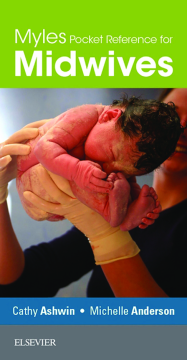
Additional Information
Book Details
Abstract
Well illustrated with over 100 figures, tables and pull out boxes this slim pocket reference includes a wealth of information ranging from communications skills, drug calculations and administration, to clinical examination and complications in labour. Designed to be carried in a scrubs/uniform pocket, this helpful guide will be ideal for all midwives whether qualified or in training.
- Helpful bullet point style enables rapid access to essential information
- Splash proof cover ensures durability
- Rich illustrative programme enables rapid access to key information
Table of Contents
| Section Title | Page | Action | Price |
|---|---|---|---|
| Front Cover | cover | ||
| IFC_Copyright page | IFC-1 | ||
| Preface | i | ||
| Table Of Contents | ii | ||
| Acknowledgements and thanks to: | iv | ||
| 1 The midwife’s role | 1 | ||
| Section 1.1 Record keeping | 1 | ||
| Section 1.2 Communication skills | 1 | ||
| Section 1.3 Drug calculations and administration6,7 | 3 | ||
| Using SI units | 3 | ||
| Formulae for dosage calculations6 | 4 | ||
| Tablets | 4 | ||
| Drugs in liquid form | 4 | ||
| Intravenous drips | 4 | ||
| 2 Uncomplicated pregnancy and birth | 6 | ||
| Section 2.1 Antenatal care | 6 | ||
| The start of care and arranging appointments | 6 | ||
| Infections | 8 | ||
| Antenatal examination | 11 | ||
| The lie of the fetus and its position | 14 | ||
| Breech presentation | 14 | ||
| Problems associated with pregnancy | 16 | ||
| Plan for birth | 16 | ||
| Section 2.2 Intrapartum | 19 | ||
| Visual aids for labour and birthing positions | 19 | ||
| Spontaneous onset of labour | 19 | ||
| Care in labour | 21 | ||
| Vaginal examination | 21 | ||
| Coping strategies for labour | 24 | ||
| In labour | 25 | ||
| Hydrotherapy | 25 | ||
| Complementary therapies | 25 | ||
| Aromatherapy | 26 | ||
| Homeopathy | 27 | ||
| Music therapy | 28 | ||
| Second stage of labour: The birth | 28 | ||
| Breech birth | 29 | ||
| Section 2.3 Fetal monitoring | 36 | ||
| Intermittent auscultation (IA) | 36 | ||
| How to perform IA | 36 | ||
| First stage of labour | 39 | ||
| Second stage of labour (including passive second stage) | 39 | ||
| Continuous electronic fetal monitoring (CEFM)51 | 39 | ||
| How to perform cardiotocography | 39 | ||
| Indications for CEFM | 40 | ||
| Section 2.4 The third stage of labour | 41 | ||
| Examination of the placenta52 | 41 | ||
| The anatomy of the placenta | 41 | ||
| Placental anomalies | 43 | ||
| 3 After the birth | 44 | ||
| Section 3.1 Postbirth: Mother and baby | 44 | ||
| The neonatal energy triangle | 45 | ||
| Section 3.2 The puerperium or postnatal period57 | 47 | ||
| The first 24 hours after birth (Box 3.1) | 47 | ||
| The first 2–7 days | 47 | ||
| From day 8 to 6–8 weeks | 48 | ||
| Section 3.3 Infant feeding | 48 | ||
| Initiation of breastfeeding | 48 | ||
| Continued successful breastfeeding63 | 49 | ||
| Section 3.4 Perinatal mental health | 51 | ||
| The universal antenatal screening pathway | 51 | ||
| 4 Conditions and factors affecting pregnancy and birth | 54 | ||
| Section 4.1 Hypertensive disorders | 54 | ||
| Section 4.2 Eclampsia | 56 | ||
| Management of eclampsia | 56 | ||
| Section 4.3 Maternal collapse | 58 | ||
| Section 4.4 Diabetes | 60 | ||
| Section 4.5 Pharmacological methods of pain relief in labour | 62 | ||
| 5 Emergencies and situations affecting birth and postpartum | 64 | ||
| Section 5.1 Complex intrapartum care | 64 | ||
| Malpresentations and malpositions | 64 | ||
| Delay in the first stage of labour | 64 | ||
| Section 5.2 Induction of labour | 65 | ||
| Prostaglandins | 65 | ||
| Rupture of membranes | 66 | ||
| Instrumental delivery and caesarean section83,84 | 68 | ||
| Section 5.3 Cord prolapse | 68 | ||
| Section 5.4 Shoulder dystocia | 69 | ||
| Section 5.5 Management of postpartum haemorrhage | 71 | ||
| Section 5.6 Episiotomy and perineal suturing | 72 | ||
| How to perform an episiotomy | 73 | ||
| Perineal suturing | 73 | ||
| Perineal suturing technique | 73 | ||
| Section 5.7 Female genital mutilation | 76 | ||
| Section 5.8 Recognition of the seriously ill woman | 77 | ||
| The Maternity Early Obstetric Warning Score (MEOWS) chart | 77 | ||
| Maternal and neonatal sepsis | 78 | ||
| Acute fatty liver in pregnancy | 78 | ||
| Obstetric cholestasis | 81 | ||
| Section 5.9 Neonatal resuscitation | 82 | ||
| Section 5.10 Neonatal jaundice | 84 | ||
| Fetal physiology in relation to jaundice | 84 | ||
| Clinical signs of jaundice | 84 | ||
| Jaundice management105 | 84 | ||
| Appendices | 87 | ||
| Appendix 1 Commonly used abbreviations | 87 | ||
| Appendix 2 Normal blood measurements | 91 | ||
| Appendix 3 Useful websites | 92 | ||
| References | 93 |
